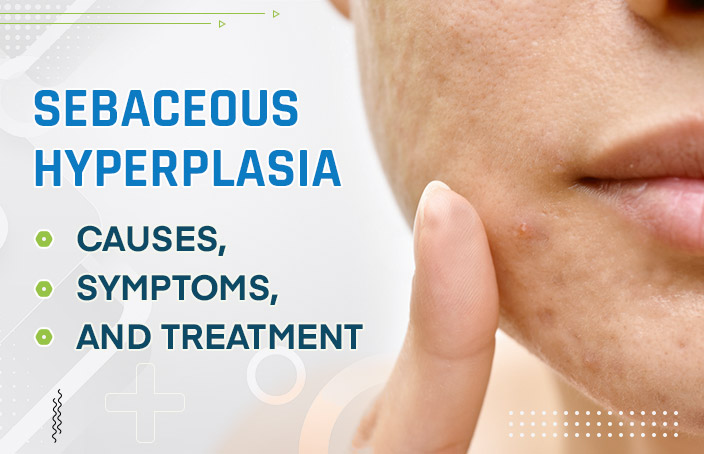Understanding Sebaceous Hyperplasia
Sebaceous Hyperplasia is a skin condition marked by small flesh-colored bumps that occur because of swollen and inflamed sebaceous glands. These small glands secrete an oily substance known as sebum that helps protect your skin from losing moisture. These glands can become backed up with oil, resulting in patches of raised bumps along the skin of your face and nose.
What Causes Sebaceous Hyperplasia, and what are the symptoms?
Sebaceous Hyperplasia is a common skin condition in older adults with fairer skin and affects nearly 1% of the total US population. Much like acne, many people suffer from this condition and without even realizing it.
The inflammation caused by sebaceous hyperplasia rarely results in pain and is generally considered mostly harmless. However, in some people, it may indicate certain genetic disorders like Muir-Torre syndrome and even some forms of skin cancers like basal cell carcinoma. If you suspect that any of your skin issues might be cancerous, you will want to consult with a medical doctor for an accurate diagnosis.
Treating Sebaceous Hyperplasia
While there is no cure for the condition, there are many different methods of sebaceous hyperplasia treatment. Some techniques are as simple as changing up your skincare routine or applying over-the-counter creams, while others are more intensive.
1. Oral Medications
A possible cause of sebaceous hyperplasia in women may result from heightened testosterone levels. Taking oral antiandrogen medications can reduce testosterone levels and reduce symptoms.
2. Laser Treatments
Dermatologists may attempt to remove lesions with laser therapy, reducing the overall size and promoting smoother skin without significant scarring.
3. Cryotherapy
With cryotherapy, a doctor can remove bumps by freezing them, causing the lesions to dry up and fall away. Cryotherapy does have the potential to cause skin discoloration in the affected area.
4. Cauterization
The process of electrocauterization involves using electricity to essentially burn off the bump entirely, allowing smoother skin to grow beneath. This form of therapy can result in skin discoloration and scarring if not performed by a skilled professional.
5. Photodynamic Therapy
This treatment method involves applying an agent to the affected cells to make them photosensitive. After this, the area is exposed to intense light that will kill the treated cells. This treatment alternative may cause extremely sensitive skin with blotches of redness and irritation.
6. Topical Chemical Treatments
Facial peels contain chemicals like salicylic acid that may help relieve symptoms of sebaceous hyperplasia. However, this treatment can also cause skin irritation and worsen symptoms if not applied correctly.
7. Excision
If symptoms of hyperplasia are severe, doctors may opt for sebaceous gland removal. This procedure will ensure that the spots do not return but can cause scarring and is generally regarded as a last-ditch effort.
8. Retinol Products
Retinol, a form of vitamin A, may help relieve symptoms in some patients. Prescription retinoids are a common treatment for patients suffering from hyperplasia.
Understanding the Difference Between Acne and Sebaceous Hyperplasia
Many skin conditions can mimic the symptoms of acne. And sebaceous hyperplasia is no different! These bumps tend to look similar to non-inflamed acne breakouts. So how can you tell the difference? With sebaceous hyperplasia, each bump will almost always have a depressed area at the center. You may also notice small blood vessels throughout the mound as well. Additionally, spots caused by sebaceous hyperplasia are missing a core and can’t be popped like acne.
Diagnosis
Most of the time, a simple visual inspection by your dermatologist is all that is required to diagnose sebaceous hyperplasia. Still, many times hyperplasia can resemble cancerous lesions like basal cell carcinoma. Therefore, your physician may choose to send off a biopsy to rule out the presence of any cancer cells.
Usually, sebaceous hyperplasia is more of a cosmetic issue than a medical concern. These bumps are often benign and not cancerous and don’t mark any precursors to future cancer issues.
Treatment Costs
Most treatment procedures for sebaceous hyperplasia are affordable, with surgical removal procedures typically costing under $1,000. Other treatments, including cryotherapy and phototherapy, may differ in price. To determine which course of treatment is right for you and your budget, you’ll want to consult with a dermatologist for a full view of their prices.
DIY Techniques to Reduce Sebaceous Hyperplasia Symptoms
There are many home and over-the-counter treatments that can soothe or reduce hyperplasia symptoms.
1. Keep your face clean
Taking the time to develop a routine around washing your face is paramount to clear, healthy skin. If you suffer from hyperplasia, gently washing your face with warm water each night for bed can help clear sebum from your skin and reduce breakouts.
2. Salicylic Acids
These over-the-counter skin treatments can help reduce sebum production from the sebaceous glands, reducing breakouts. However, the acidic nature of these treatments can cause skin irritation and inflammation.
3. Warm Compresses
In addition to regularly washing your face, applying warm compresses can keep your pores open and your skin clear of oils and debris that cause both acne and sebaceous hyperplasia.
4. Avoid UV Exposure
As with any skin condition, minimizing exposure to the sun is one of the most critical aspects in relieving skin issues and reducing the chances of skin cancer. Always make sure to use SPF-appropriate sunscreen anytime you’re exposed to sunlight, even in cold climates and on overcast days.
Connect with Winston Salem Dermatology Today
Sebaceous hyperplasia is a common skin condition that affects many Americans daily. There is no known way to prevent the condition, but you can take steps to minimize symptoms. Your first step will be to contact a dermatologist for a consultation.
Winston Salem Dermatology specializes in diagnosing and treating skin conditions like sebaceous hyperplasia, acne, psoriasis, and rosacea. We also offer numerous cosmetic procedures, including IPL therapy and laser hair removal.
Take back your skin’s health and reclaim that youthful glow! Give us a call today at (336) 774-8636 and let our team of experts help.


